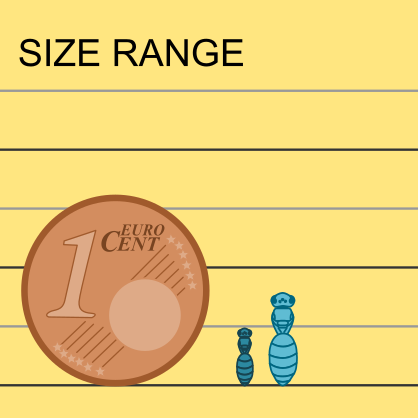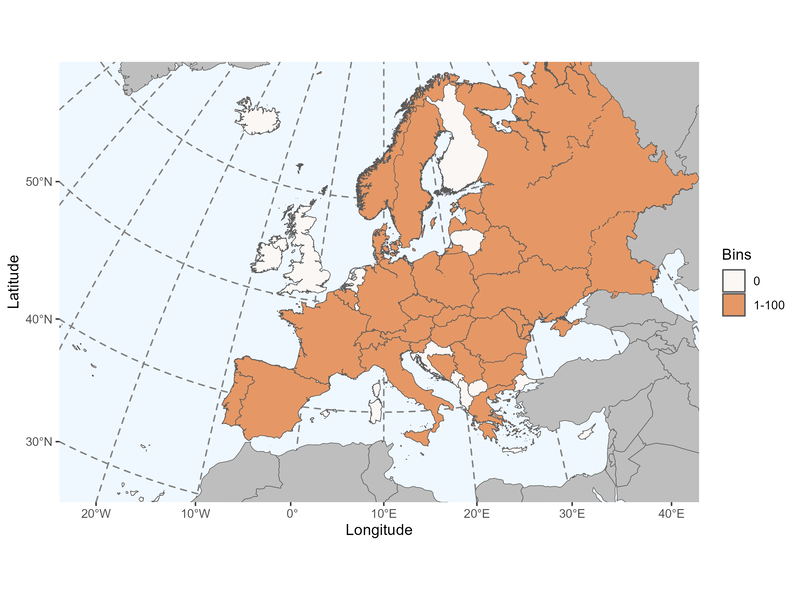Author: Panzer, 1806
|
Type species: Tiphia brevicornis Panzer, 1798, monobasic.
Synonyms: Rhineta Illiger, 1807; Melittoxena Morawitz, 1873; Biastoides Schenk, 1874; |
Clade: Anthophila
Family: Apidae Subfamily: Nomadinae Tribe: Biastini |
|
Distinctive traits
|
Pictures of distinctive traits
|
Morphologically close genera, and how to distinguish them:
Ammobates and Pasites species have a normal scapus, longer. Females have a propodeal triangle faint and a unidentate mandible. Males have a labrum longer than wide.
Ammobatoides & Schmiedeknechtia species have an oval or pointed marginal cell, basal part of submarginal cell 1 is around twice as long as that of submarginal cell 2. Males have strongly converging eyes.
Clavipanurgus, Flavipanurgus, Panurginus, Panurgus & Simpanurgus species have a flat clypeus and a short-tongue morphology of mouthparts (short maxillary palpi).
- Biastes - Ammobates & Pasites
Ammobates and Pasites species have a normal scapus, longer. Females have a propodeal triangle faint and a unidentate mandible. Males have a labrum longer than wide.
- Biastes - Ammobatoides & Schmiedeknechtia
Ammobatoides & Schmiedeknechtia species have an oval or pointed marginal cell, basal part of submarginal cell 1 is around twice as long as that of submarginal cell 2. Males have strongly converging eyes.
- Biastes - Clavipanurgus, Flavipanurgus, Panurginus, Panurgus & Simpanurgus
Clavipanurgus, Flavipanurgus, Panurginus, Panurgus & Simpanurgus species have a flat clypeus and a short-tongue morphology of mouthparts (short maxillary palpi).
General comments on Biastes species identification
Species identification criteria include the presence of spots of white hairs on the mesopleuron (B. emarginatus), the abdomen(B. truncatus) or neither (B. brevicornis).
Species identification criteria include the presence of spots of white hairs on the mesopleuron (B. emarginatus), the abdomen(B. truncatus) or neither (B. brevicornis).
Sorry, but the species identification tool is not yet available for Biastes.
Please check the reference(s) at the bottom of the page for traditional keys.
Please check the reference(s) at the bottom of the page for traditional keys.
List of the 3 Biastes species found in Europe (Ghisbain et al. 2023):
Biastes brevicornis (Panzer, 1798)
Biastes emarginatus (Schenck, 1853)
Biastes truncatus (Nylander, 1848)
Biastes brevicornis (Panzer, 1798)
Biastes emarginatus (Schenck, 1853)
Biastes truncatus (Nylander, 1848)
References with identification keys for some of the species:
- Osytshnjuk, A.Z., Panfilov, D.V. & Ponomareva A.A. (1978) Superfamily Apoidea. In: Tobias, V.I. (Ed). Key to the insects of European part of the USSR. Vol. 3. Hymenoptera. Pt. 1. Nauka, Leningrad, 279-519. (In Russian)
- Amiet F., Herrmann M., Müller A. & Neumeyer R., 2007. Apidae 5. Ammobates, Ammobatoides, Anthophora, Biastes, Ceratina, Dasypoda, Epeoloides, Epeolus, Eucera, Macropis, Melecta, Melitta, Nomada, Pasites, Tetralonia, Thyreus, Xylocopa. Fauna Helvetica 20. Centre suisse de cartographie de la faune (CSCF), Neuchâtel, 356 pp.
Page contributors:
You noticed a mistake? You have a suggestion to improve this page?
Don't keep it to yourself, contact us and become a contributor to IDmyBee!
References used to write this page:
- Adrien Perrard (Dec. 2023)
- Adrien Perrard (Dec. 2019)
You noticed a mistake? You have a suggestion to improve this page?
Don't keep it to yourself, contact us and become a contributor to IDmyBee!
References used to write this page:
- Ghisbain, G., Rosa, P., Bogusch, P., Flaminio, S., Le Divelec, R., Dorchin, A., Kasparek, M., Kuhlmann, M., Litman, J., Mignot, M., Müller, A., Praz, C., Radchenko, V.G., Rasmont, P., Risch, S., Roberts, S.P.M., Smit, J., Wood, T.J., Michez, D. & Reverte, S. (2023). The new annotated checklist of the wild bees of Europe (Hymenoptera: Anthophila). Zootaxa, 5327(1), 1-147.
- Michener, C.D. 2007. The Bees of the World, 2nd Edition. The John Hopkins University Press, Baltimore.
- Michez D., Rasmont P., Terzo, M., Vereecken, N. 2019. Abeilles d'Europes. Hymenoptères d'Europes, Volume 1. N.A.P. Editions.
- Nieto, A., Roberts, S. P., Kemp, J., Rasmont, P., Kuhlmann, M., García Criado, M., ... & Michez, D. 2014. European red list of bees. Luxembourg: Publication Office of the European Union, 98. (IUCN 2014)
- Rasmont, P., Devalez, Jelle, Pauly, A., Michez, D. & Radchenko, V.G. 2017. Addition to the checklist of IUCN European wild bees (Hymenoptera: Apoidea). Annales de la Société entomologique de France 53: 17-32.



